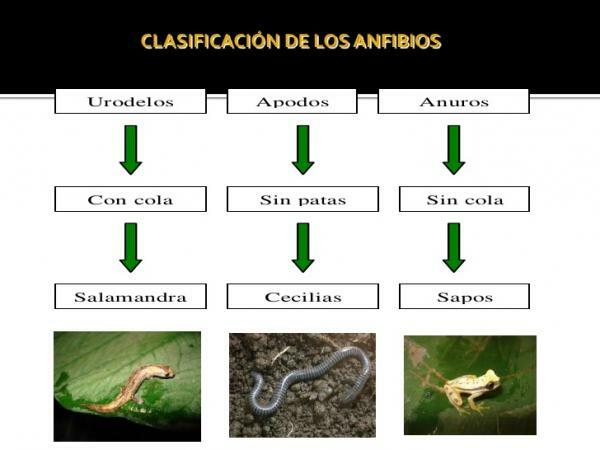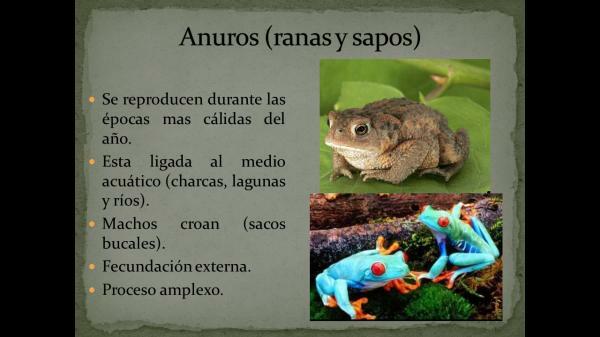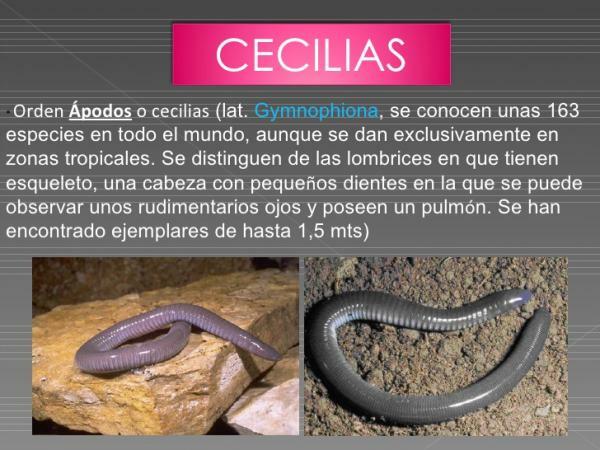Know the CLASSIFICATION of AMPHIBIA

Image: Slideshare
Amphibians are very interesting and varied animals. The word amphibians means "two lives" and refers to the fact that they live in water during the first stages of life and then move on to live on dry land when they are adults. The group of amphibians includes many different types of animals, from the well-known frogs and toads to the unknown caecilians, through newts, salamanders or the so fashionable axolotls. In this lesson from a TEACHER we will see a amphibian classification so that you know what amphibians are, what is their important role in the different ecosystems in which they live and the main characteristics of each of the groups, including examples! If you don't want to miss out on a ton of facts and trivia about amphibians, keep reading!
Index
- What are amphibians? Importance of amphibians in nature
- Anurans: frogs and toads
- The urodelos: salamanders and newts
- Apods: caecilians
What are amphibians? Importance of amphibians in nature.
The amphibiansThey are the oldest groups of vertebrates and their transition from living in the aquatic environment to the terrestrial environment was a milestone. Despite this, amphibians are not totally terrestrial, since they depend on the aqueous environment to lay their eggs and develop during their early stages of life. Thanks to the metamorphosis, amphibians are able to lay their eggs in the watery environment and develop as aquatic animals while they are larvae or tadpoles, to later go on to generate legs and lungs and be able to adapt to the adult land route. In addition to carrying out metomorphosis, amphibians have a water-permeable skin and does not have body regulation mechanisms; This means that amphibians are always in very humid environments and in more or less temperate climates to avoid desiccation and an excessive rise in body temperature.
Amphibians are animals that perform several very important functions within the ecosystems of which they are a part. On the one hand, amphibians serve as link between the aquatic environment and the land environment: they grow during the first stages of their life in water, where they contain nutrients and energy, which later become part of the terrestrial environment when they are adults. In addition, they feed on insects and small invertebrates, some of them aquatic, which allows their use for pest control of other species.
Thanks to their double life, amphibians can be used as "ecological thermometers", that is, to measure the quality of the ecosystems of which it is part, especially the quality of the waters. If the quality of the waters where the animal lives is not adequate, the amphibian will simply go to the terrestrial environment and will look for another suitable environment, it will leave the contaminated environment. Finally, amphibians use toxic substances and poisons to defend themselves not only from other animals, but also from bacteria, viruses and fungi that threaten them. These substances are studied for preparation of medicines, substances to eliminate pests, disinfectants, etc..

Image: Slideshare
Anurans: frogs and toads.
Within the amphibian classification we must know the anurans they are the best known group of amphibians, although not the largest. This group includes toads and frogs, animals that we can easily differentiate thanks to their bright colors, short body, more or less wide without neck or tail. In addition, they have a very characteristic head: it is wide, with a large mouth and bulging eyes and no lids; its large mouth hides a protctile tongue, that is, it projects outwards and allows it to hunt flying insects such as flies and mosquitoes.
The legs of the anurans are also very special. At the end of its front legs we find four toes while in the back they have five; these fingers are joined by membranes (interdigital membranes) that allow them to swim and jump better. Precisely to jump, the anurans have the legs highly developed posterior. Also, in some species, at the end of the fingers there are suction cups, which help them stick to vertical surfaces and walls.
Here we offer you a list of the different types of amphibians that exist.

Image: Slideshare
The urodelos: salamanders and newts.
The urodelos they are animals with him longer body than the anurans, who have four short and equal legs. The group of urodels can also be called caudates, since they have at the end of their body a tail quite long in relation to its size.
His head, unlike toads and frogs, it is flattened and shaped like arrow. In its mouth it hides, unlike the anurans, teeth in both jaws. In terms of their mode of locomotion, urodelos move by walking on their legs, with slightly lateral movements reminiscent of small snakes.
One of the most curious properties of urodels is that they can regenerate certain parts of your body. When cut cleanly, some urodelos, such as lizards, can regenerate parts of the tail or some limbs. Another of the most recognizable characteristics is that some species retain characteristics of the larvae when they are adults (such as the presence of gills in the axolotl).

Image: Pinterest
The apodes: the caecilians.
We continue with the classification of amphibians to now talk about apods. The apodal They are the least known class of amphibians in our latitudes, but they are well known and abundant in humid tropical regions. These amphibians are characterized by having worm-like shape: elongated, with a small tail and no legs (hence the term apodal); also, many of them they live on the ground which makes them much more confused with other animals such as earthworms (from which they differ because the latter do not have heads).
The head is very adapted to their way of life: they have a sturdy skull, well protected, that allows them to excavate the earth without damaging themselves. Their eyes they are small and underdeveloped, and they are guided through the smell. Its movement is similar to that of other vermiform animals: they move with wave movements, describing waves with the body, thanks to the mobility that the rings of their body give them.
One of the most amazing characteristics of caecilians is their diet: celilias are carnivorous, and they feed on small worms, insects, small snakes or even small amphibians.

Image: Animal info
If you want to read more articles similar to Amphibian classification, we recommend that you enter our category of biology.
Bibliography
- Beltrán Díaz, N., Martínez Ruíz, R. and Perales Rodríguez, J. (2016) Guide to amphibians of Spanish national parks. Madrid: ICONA https://www.miteco.gob.es/eu/red-parques-nacionales/red-seguimiento/pima-adapta/guia_anfibios_imprenta_baja_tcm35-61881.pdf
- Belmonte, A. (March 13, 2019). Types of amphibians and their characteristics. Recovered from https://www.unprofesor.com/ciencias-naturales/tipos-de-anfibios-y-sus-caracteristicas-3178.html
- Wikipedia (January 23, 2019) Gymnophiona. Recovered from: https://es.wikipedia.org/wiki/Gymnophiona
- Wikipedia. (March 6, 2019) Caudata. Recovered from https://es.wikipedia.org/wiki/Caudata
- Wikipedia (July 27, 2019). Anura. Recovered from https://es.wikipedia.org/wiki/Anura


